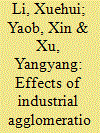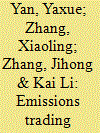|
|
|
Sort Order |
|
|
|
Items / Page
|
|
|
|
|
|
|
| Srl | Item |
| 1 |
ID:
185560


|
|
|
|
|
| Summary/Abstract |
On 16 September 2014, Indonesian lawmakers unanimously agreed to ratify the ASEAN Agreement on Transboundary Haze Pollution (AATHP), becoming the last ASEAN member state to ratify. Eight of the 10 member states had ratified by 2006, and nine had ratified by 2010. Although the ratification bill reached the Indonesian Parliament during the 2000s, it was always disapproved. This article seeks to re-examine Indonesia’s lengthy delay and address its long-awaited ratification. Accordingly, we build on Robert Putnam’s theory of ratification from two-level game theory and develop a framework for analysing delayed ratifications. Although the negotiated AATHP was ‘soft’ and thus low-cost for domestic stakeholders, key domestic stakeholders had little appetite for ratification and limited substantive pressure came from neighbouring governments during the 2000s. However, in the context of heightened public concern and calls for government action and positive palm oil industry responses to international pressures, persistent international pressure and measures during the 2010s, particularly from Singapore, provided parliamentarians with enough incentive to symbolically ratify the agreement. Addressing Indonesia’s delayed ratification is important in understanding ASEAN’s ongoing struggle to combat transboundary haze pollution and offers a useful case study in the still-developing area of ratifications in the environmental regime formation literature.
|
|
|
|
|
|
|
|
|
|
|
|
|
|
|
|
| 2 |
ID:
162956


|
|
|
|
|
| Summary/Abstract |
To study the effect of the air pollution charging fee (APCF) policy on the haze pollution in China, a dynamics management model is constructed with the approach of system dynamics and implemented by using the Vensim software. This model is used to simulate and assess the effect of APCF policy on the traffic and the emissions (particularly carbon monoxide (CO), hydrocarbons (HC), nitrogen oxides (NOx), and particulate matter (PM)) in Beijing during the years 2011–2025 in different scenarios. The validity and the robustness of the model are verified by a model test and validation, and a reasonable range of APCF is determined by using a sensitivity analysis. The simulation results showed that the APCF policy effectively realized the “win-win” scenario of emission reduction and congestion release. In particular, the simulation results also indicated some policy effects such as rebound effect (from low-APCF policy), inflection-point effect (from high-APCF policy), and marginal decreasing effect (between moderate and high-APCF policy). These results provide some valid policy recommendations for energy management and emission reduction.
|
|
|
|
|
|
|
|
|
|
|
|
|
|
|
|
| 3 |
ID:
175906


|
|
|
|
|
| Summary/Abstract |
Environmental issues, especially air pollution, have attracted much attention with the development of economy in China. In order to provide a new idea for how to perfect the mechanism of regional joint prevention and control of air pollution, this paper empirically estimates the spatial spillover effect of industrial agglomeration on haze pollution. The results show that the haze pollution has a significant positive correlation with the industrial agglomeration levels in local and neighboring regions. Direct and indirect effects of the industrial agglomeration are all significantly positive, and the latter are much higher than the former. It indicates that the haze pollution is not only affected by the industrial agglomeration in the local region, but also neighboring regions. Furthermore, we find that the direct and indirect effects in central and western China exceed those in eastern China. In addition, the direct and indirect effects of industrial agglomeration in heavily polluting industry are higher compared with non-heavily polluting industry.
|
|
|
|
|
|
|
|
|
|
|
|
|
|
|
|
| 4 |
ID:
171482


|
|
|
|
|
| Summary/Abstract |
The study aims to employ the difference-in-differences method and mediating effect model to assess panel data of 267 prefectural-level cities in Chinese 30 provinces from 2003 to 2016 and empirically examines whether the Emissions Trading System pilot has realized collaborative governance effects upon air pollution. This study verifies the rationality of the element design of China's Emissions Trading System pilot from the perspective of environmental effects. The results indicate that the China's Emissions Trading System pilot does have a significant ‘reduction effect’ on haze pollution concentration level, which is probably achieved by ‘boosting the application and transformation of green technologies among enterprises’ and ‘transferring heavily polluted industries’. Moreover, the total quota allocation, total number of incorporated enterprises and the entry of institutional and individual investors were not the significant influencing factors for reducing haze pollution, while the transaction volume of China Certified Emission Reduction and the total penalty amounts incurred play significant roles. The heterogeneity test shows that only Guangdong province's policy has a significantly negative effect on haze pollution concentration. This study provides a new way of thinking for the coordinated governance mode by combining environmental governance and carbon trading scheme. The experiential evidence strongly supports the establishment and improvement of China's Emissions Trading System pilots and the implementation of a unified national carbon market.
|
|
|
|
|
|
|
|
|
|
|
|
|
|
|
|
|
|
|
|
|